
Michele Lyons | Triple Crown Pomeranians & Biewer Terriers
Michele Lyons is the breeder behind Triple Crown Pomeranians & Biewer Terriers. Read about the kennel’s beginnings, the puppies, and more!

Home » Dog Breeds » Pomeranian Dog Breed
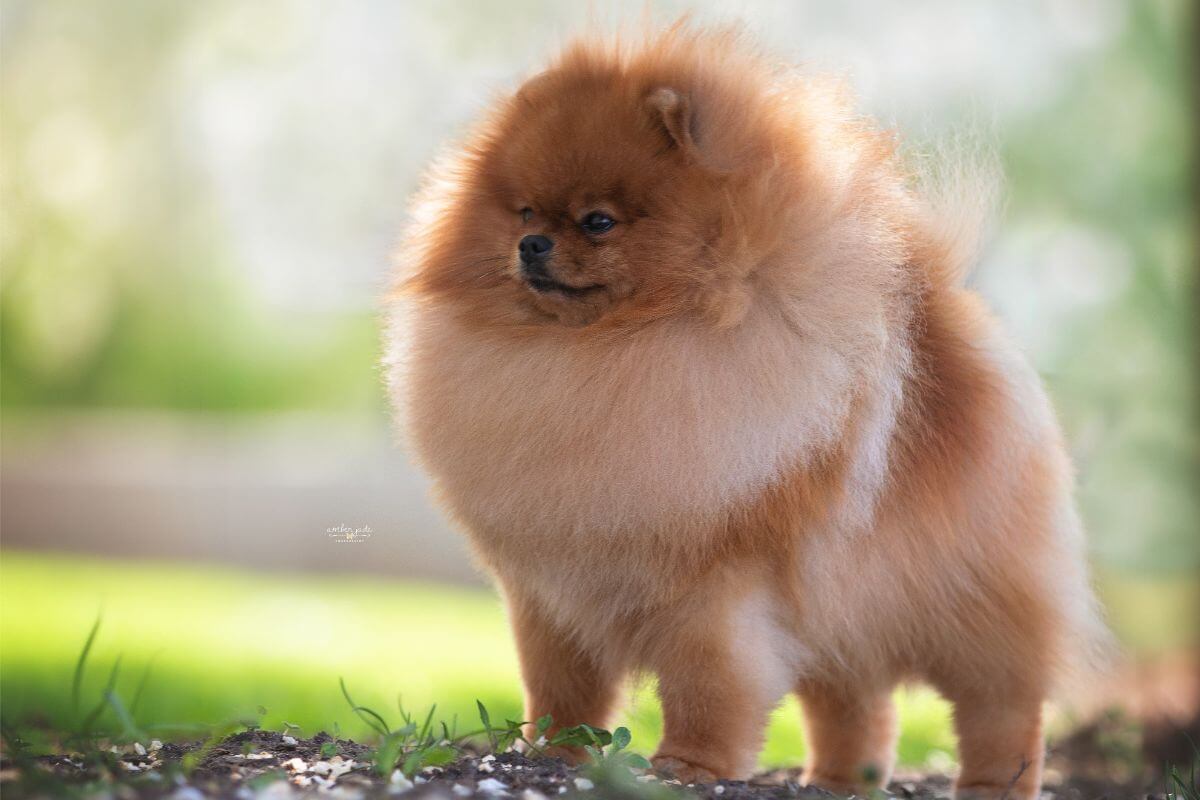

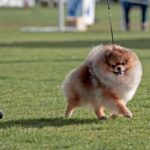

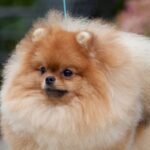
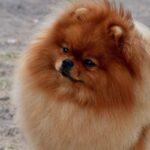
The Pomeranian, affectionately known as the “Pom” by its legion of admirers, is a spitz-type breed that presents the picture of a dog of very high style in a very small package. This diminutive canine is every bit as commanding as its larger Nordic cousins, with a vivacious and spirited nature that has endeared it to both royals and commoners for centuries. Renowned for its compact yet sturdy frame and fox-like expression, the colorful and cocky Pomeranian remains a popular choice as a companion for people who appreciate a dog that’s as spirited as it is splendid.
Toy
6 – 7 inches
3 – 7 pounds
12 – 16 years
| Country of Origin | Germany |
|---|---|
| Bred For | Companionship |
| Known For | Compact Size, Fluffy Coat, Intelligence |
| Popularity | High |
| Temperament | Inquisitive, Lively, Bold |
| Activities | Running, Walking, Conformation Shows, Dog Sports |
The Pomeranian, a spitz-type dog with a rich and storied history, has evolved significantly over the past two and a half centuries. The breed’s development began in Northern Europe’s Pomerania region, an area that now spans modern-day Poland and Germany. The dogs were originally sturdy working dogs used for herding sheep and protecting homes. Those early dogs were significantly larger than the contemporary Pom, sometimes weighing as much as 30 pounds.
The transformation of the Pomeranian into the diminutive and ornamental companion recognized today is a fascinating journey that parallels the interests of one of Europe’s royal monarchs. It was Queen Victoria of England who played a pivotal role in the breed’s development. During her reign, she fell in love with a smaller-sized Pomeranian named “Marco” while visiting Italy. Marco, weighing only 12 pounds, was significantly smaller than the Pomeranians of that era. Queen Victoria’s fondness for this dog, and her decision to bring him back to England, sparked a trend for smaller Pomeranians among British nobility, and subsequently, around the world.
This royal influence led to a focused breeding effort to reduce the size of the Pomeranian while enhancing its distinctive features, such as the breed’s luxurious coat and spirited personality. By the late 19th century, the Pom had become a favorite in both the show ring and as a companion dog.
The American Kennel Club (AKC) officially recognized the Pomeranian in 1888, a testament to the breed’s growing popularity in the United States. Similarly, The Royal Kennel Club (UK) and the Fédération Cynologique Internationale (FCI) have long recognized the breed, further solidifying its status as a dog of distinction in the canine world.
Throughout the 20th century, the Pomeranian continued to evolve and gain popularity. The breed has been owned and adored by historical figures and celebrities, adding to its allure and status. Notably, two Poms were among the few animal survivors of the Titanic, highlighting the breed’s presence in significant historical events.
The breed’s purpose has also shifted over time. From a robust working dog to a smaller-sized companion, the Pomeranian has adapted to changing societal tastes and needs. Today, these little and lively dogs are cherished for their commanding character, impressive intelligence, and affectionate nature, making them popular pets worldwide.
The Pomeranian’s history is a testament to the breed’s adaptability and enduring appeal. From working as a farmhand to achieving stardom as a royal lapdog (to stealing the hearts of millions), the Pomeranian has secured its place as a beloved breed in the pantheon of prototypical purebreds.
A male Pomeranian usually stands about 7 to 12 inches tall at the shoulder, while an adult female typically measures slightly shorter.
The weight of a healthy adult Pomeranian ranges from 3 to 7 pounds, with the male generally being on the upper limits of this scale.
The Pomeranian is a square breed with a short back, exhibiting a length-to-height body ratio of 1 to 1. This proportion gives the Pom a balanced and compact appearance, emphasizing the breed’s sturdy and robust build. The breed’s substance is attributed by medium bone and good muscle tone that contribute to its overall display of vim and vigor. Despite the breed’s small stature, a Pomeranian carries itself with great dignity and pride.
Texture: The Pomeranian boasts a distinctive double coat that is one of its most recognizable features. The outer coat is long, straight, and harsh in texture, providing a beautiful, profuse appearance. The abundant outer coat forms a ruff around the neck, framing the head, extending over the shoulders and chest. The coat on the head and legs is shorter in length , thought he forelegs are well-feathered, and the thighs and hind legs for a skirt. The outer coat is complemented by a soft, dense undercoat, which adds significantly to the breed’s plush look. The combination of these two layers not only contributes to the breed’s striking silhouette, it also serves as protection in inclement weather. Trimming of the coat is often done for neatness, though too much can compromise the coat’s protective qualities.
| Standard Color | |
|---|---|
| Blue Merle | ee |
| Blue Brindle | ee |
| Chocolate Merle | ee |
| Blue Sable | ee |
| Black | ee |
| Black & Tan | ee |
| Blue | ee |
| Blue & Tan | ee |
| Chocolate | ee |
| Chocolate & Tan | ee |
| Cream | ee |
| Cream Sable | ee |
| Orange | ee |
| Orange Sable | ee |
| Red | ee |
| Red Sable | ee |
| Beaver | ee |
| Brindle | ee |
| Chocolate Sable | ee |
| White | ee |
| Wolf Sable | ee |
| Beaver Sable | ee |
| Tri-Colored | ee |
| Black & Brindle | ee |
| Standard Marking | |
|---|---|
| Parti-Color | ee |
| Mask | ee |
| White Markings | ee |
| Tan Markings | ee |
| Brindle | ee |
| Irish Marked | ee |
| Tri Color Markings | ee |
| Sable | ee |
| Merle Markings | ee |
The tail of the Pomeranian is one of the breed’s most distinctive and defining features, significantly contributing to the breed’s silhouette and overall appearance. Set high and carried proudly, the tail lies flat and straight against the back. It is adorned with long, harsh, straight hair, giving it a profuse look that is an unmistakable breed characteristic.
Among Pomeranian breeders, the way the dog’s tail is carried is of paramount importance. It not only enhances the breed’s typical outline but also serves as an indicator of the dog’s spirited and vivacious nature.
The Pomeranian, with its vibrant personality and luxurious coat, is a delightful breed that has captured the hearts of countless dog lovers. While the breed’s appeal is undeniable, owning a Pom comes with specific responsibilities and considerations. Prospective owners need to be aware of the breed’s unique needs to determine if a nurturing environment can be provided for the dog.
Pomeranians are generally a hardy breed, but like all breeds and mixed breeds, they have certain health considerations that should not be overlooked. Prospective caretakers must understand these potential health issues and work closely with a reputable breeder and veterinarian to safeguard the Pom’s overall good health.
A Pomeranian typically enjoys a lifespan ranging from 12 to 16 years. With attentive care, regular health check-ups, and a well-balanced diet, many Poms live full and healthy lives, often reaching the upper end of this range.
Despite the breed’s overall resilience, Pomeranians are susceptible to certain health conditions, including:
It is crucial to have regular veterinary check-ups to detect these and other potential health issues early. Wellness exams, including specific tests for knee stability, thyroid function, and heart health, play a critical role in maintaining the well-being of a Pomeranian.
Understanding the Pomeranian’s personality is key to fostering a harmonious relationship with this breed. Poms are known for their lively and playful nature, packed into a small but confident package. Their intelligence and alertness make them excellent companions, but these same traits mean they require proper socialization and training to help them develop into well-rounded adults.
Pomeranians are generally suitable for novice owners, as they are eager to please and respond well to positive reinforcement training methods. However, their intelligence and sometimes stubborn streak mean they benefit from consistent, patient training from an early age. Despite their small size, these dogs have big personalities and can develop “small dog syndrome” if not properly guided.
The Pom’s sensitivity level is relatively high, making these dogs very attuned to their environment and their human companions’ emotions. This sensitivity requires mindfulness in every interaction, since these small spitz can be easily affected by harsh words or actions.
Regarding being alone, Pomeranians can be prone to separation anxiety if left on their own for extended periods. They thrive on companionship and interaction, so they’re best-suited to homes where they won’t be alone for hours on end. Poms enjoy being the center of attention and can become vocal or destructive if they feel neglected.
In terms of getting along with other dogs and young children, Pomeranians can do well if socialized from an early age. However, due to their small size, interactions with larger dogs and very young children should always be supervised to prevent accidental injury. Poms generally have a friendly disposition, but they can be reserved or shy around strangers. This can be mitigated with proper socialization throughout the puppy’s first year.
Feeding and nutrition are crucial aspects of caring for a Pomeranian. The breed’s small size, high energy levels, and dietary needs must be considered to maintain good health and vitality. It’s always important to tailor a dog’s diet to its life stage, size, and activity level.
For Pomeranian puppies, it’s essential to provide a diet that supports rapid growth and development. Puppies should be fed high-quality, small-breed puppy food, one that is specifically formulated to meet the nutritional needs of growing small dogs. This food is usually higher in protein and essential nutrients to support their development.
Pom puppies typically eat more frequently than adults, usually three to four times a day. As they transition to adulthood, they should be switched to a diet that supports their growing energy levels. Adults typically do well on two meals a day, but the amount of food required can vary. Generally, Pomeranians eat about one-quarter to one-half cup of dry dog food per day.
The quality of the food given is also important. Feeding a high-quality, balanced diet designed for small breeds can help a Pomeranian receive the proper nutrition. This includes the right balance of proteins, fats, carbohydrates, vitamins, and minerals.
In addition to providing regular meals, Pomeranians can be given treats, but these should be given sparingly and not exceed 10 percent of the dog’s total caloric intake. It’s also important to provide fresh water at all times.
Regular check-ins with a veterinarian can help to ensure that the Pomeranian’s dietary needs are being met. During each visit, adjustments can be made as needed based on the dog’s age, overall health, and activity level. A well-balanced diet will play a significant role in keeping the Pom healthy, active, and happy throughout its life.
Training a Pomeranian, while enjoyable due to the breed’s intelligent and curious nature, does come with a few unique challenges. Understanding and effectively managing these challenges is key to raising a well-behaved and sociable companion.
Pomeranians are intelligent dogs, which means they learn quickly, but this intelligence can sometimes lead to a streak of stubbornness. Therefore, consistent and patient training is essential from an early age. These dogs respond best to positive reinforcement techniques such as praise, play, and treats. Harsh methods, or negative reinforcement, can lead to distrust and undesirable behaviors.
Despite the breed’s small size, Pomeranians have a strong vocal presence. They can be prone to barking, which may be a way of expressing themselves or alerting their human companions to anything unusual. Training them to understand commands like “quiet” can help to manage any excessive barking. Early socialization and exposure to different people, environments, and situations can also help to reduce nervousness and mitigate overexcitement.
Their intelligence also means Pomeranians enjoy and benefit from mental stimulation. Puzzle toys, interactive games, and regular training sessions can help to keep their minds active and prevent boredom from being expressed in destructive, and annoying, ways.
When it comes to training a Pomeranian, it’s important to remember their role as a companion dog with a working background. While these spitz-type lapdogs may not have a high prey drive, they can be curious and inclined to explore if given the opportunity. Therefore, it’s important to have a secure environment and to teach them a reliable recall at home and in public.
Exercise is an essential aspect of a Pomeranian’s daily routine, crucial for the dog’s physical health and mental well-being. Despite the breed’s small size, Poms are energetic and lively, requiring regular opportunities to run around and play.
| Energy Level | High |
|---|---|
| Exercise Requirements | 50 Minutes/Day (Minimum), Daily Walks, Vigorous Running, Regular Exercise, Mental Stimulation |
The exercise needs of a Pomeranian, while not as extensive as those of larger breeds, are still significant. This breed benefits greatly from a daily walk, which not only provides physical exercise but also mental stimulation and opportunities for socialization. A couple of short walks each day, combined with playtime, is usually sufficient to meet the Pom’s exercise needs.
In terms of energy level, Pomeranians are generally high-spirited and playful. These dogs enjoy activities that engage their minds as well as their bodies. Interactive games, such as fetch or hide-and-seek with toys, can be excellent ways to provide mental and physical stimulation. These activities also strengthen the bond between dog and owner.
The intensity of exercise should be tailored to the individual dog. Some Poms have boundless energy, while others may prefer more rest and relaxation. It’s important to observe and understand each dog’s preferences and endurance levels to avoid overexertion.
Playfulness is a hallmark of the Pomeranian. These dogs often enjoy playing and can be quite entertaining with their antics. Providing a variety of toys will help to keep them engaged and entertained, especially when they’re at home on a rainy day.
The Pomeranian is known for its luxurious double coat, which requires regular and attentive grooming. Coat care is a crucial aspect of living with this breed, not only for maintaining the dog’s striking appearance but also for its overall health and well-being.
| Coat Type | Double, Abundant, Medium Length, Coarse |
|---|---|
| Grooming Requirements | Weekly Brushing, Occasional Bathing, Routine Ear Cleaning, Periodic Nail Trimming, Regular Tooth Brushing |
The Pomeranian can be a challenge to groom due to the breed’s thick, plush coat. Regular brushing is essential to prevent mats and tangles, which can be uncomfortable for the dog and difficult to remove. Brushing a few times a week, or even daily, with a brush helps to remove loose hair and distribute the skin’s natural oils through the coat, keeping it healthy and strong.
The amount of shedding for a Pomeranian can vary, but these dogs are generally considered to be moderate-to-heavy shedders. Regular brushing helps with managing the shedding by removing loose hairs before they end up on clothing and furniture. During the spring and fall shedding seasons, Poms may require more frequent grooming.
In addition to coat care, other grooming tasks are important for maintaining a Pomeranian’s health. This includes regular tooth brushing to prevent dental issues, which Poms can be prone to due to their small jaws. Ears should also be checked regularly and kept clean to prevent infections, and nail trimming is important to prevent discomfort and mobility issues.
While some people choose to groom their Pomeranian at home, professional grooming can be a helpful option, especially for trimming the nails and dealing with mats. A professional groomer can also provide advice on the best grooming practices and products for your specific dog.
Regular grooming is not just a matter of aesthetics for the Pomeranian; it is a vital part of the dog’s care. Grooming helps with maintaining overall health, allows for regular inspection of the skin and coat for any issues, and strengthens the bond between the dog and the groomer. Good grooming habits should be established early on so that the Pom becomes comfortable with the process and looks forward to every session.
Living with a Pomeranian can be a highly rewarding experience, but it also requires consideration of the breed’s specific needs and preferences. The Pom’s small size and outgoing personality traits mean these dogs can have unique requirements in terms of their living environment.
Pomeranians are well-suited to apartment life due to their small size. They don’t need a large space to be happy and can thrive in smaller homes as long as their exercise needs are met and they’re mental stimulated throughout each day. However, the breed’s tendency to bark should be considered, especially in close living quarters. Training to manage any excessive barking is important to foster a harmonious living situation, both for the dog and for neighbors.
Regarding the breed’s adaptability to changes in the weather, Pomeranians are generally better suited to cooler climates due to their thick double coat. This coat provides insulation, making them more comfortable in colder temperatures. However, it’s important to protect them from extreme cold and to provide a warm and cozy place for them inside the home.
In hot weather, Poms can be prone to overheating. Owners should make sure the dogs have access to shade, fresh water, and air conditioning or fans for keeping cool during hot spells. Avoiding intense outdoor exercise during the hottest parts of the day is also advisable.
When considering a Pomeranian as a companion, it’s important to be mindful of the breed’s small stature. These dogs can be easily injured by rough play or accidental mishaps, so care should always be taken, especially in households with young children or larger pets. Safe spaces where the Pom can retreat to if it’s feel overwhelmed or threatened are beneficial.
The arrival of a litter of Pomeranian puppies is an exciting and enriching experience that requires constant attention during the first few weeks of life. Each fluffy bundle of joy will grow up to become a lively and affectionate companion, making early training and socialization crucial for the development of a well-adjusted adult.
Caring for a Pomeranian puppy involves several important considerations for supporting healthy growth and development. Initially, it’s essential to provide a safe and nurturing environment for the puppy. This includes having a dedicated space for sleeping and eating, as well as a secure area for play and exercise.
Nutrition is a vital component of a puppy’s growth, and feeding a high-quality food formulated for small breed puppies is crucial. This diet supports proper growth and development, providing the nutrients that are necessary for a healthy start. Establishing a regular feeding schedule and portion control is also important to avoid overfeeding, which can lead to obesity and associated health problems in the future.
Early socialization is a critical aspect of care for the Pomeranian puppy. Introducing the little one to new people, animals, environments, and experiences helps in developing their social skills and shaping a confident adult temperament. Positive and gentle interactions during the early months and years are key in influencing their future behaviors.
Formal training should begin from a young age, focusing on basic commands and housetraining. Employing positive reinforcement methods, like using treats and praise, are effective and help in building a strong bond between the puppy and its favorite person. Crate training can be beneficial too, providing the puppy with a secure space to rest and sleep through the night.
Regular veterinary check-ups are crucial for monitoring the puppy’s health, making sure it receives all the necessary vaccinations and preventive care. These visits also allow time to discuss any concerns about the puppy’s development and overall well-being.
Pomeranians are lively and intelligent dogs that can excel in a wide variety of dog sports. These activities not only provide physical challenges and mental stimulation, they also strengthen the bond between the dog and its handler. Here are some activities and sports suitable for Pomeranians.
These dog sports and activities provide excellent opportunities for Pomeranians to engage in physical exercise, mental stimulation, and social interaction. Participation can lead to a more balanced and happy life for both the Pom and its owner.
The Pomeranian is recognized by the world’s leading registries and kennel organizations, which categorize the breed into a specific Group based on its unique characteristics. This breed is recognized worldwide under the following Group designations:
| Organization | Group Designation |
|---|---|
| AKC (American Kennel Club) | Non-Sporting |
| UKC (United Kennel Club) | Companion Dog |
| CKC (Canadian Kennel Club) | Non-Sporting |
| ANKC (Australian National Kennel Council) | Non Sporting |
| RKC (The Royal Kennel Club) | Utility |
| FCI (Fédération Cynologique Internationale) | Group 9 – Companion and Toy Dogs; Section 11 – Small Molossian Dogs |
The ideal Pomeranian is described by a Breed Standard that is approved by each of the world’s leading registries and kennel organizations. The Breed Standards for this breed may be found in the following links:
| Organization | Breed Standard |
|---|---|
| American Kennel Club | AKC Pomeranian Breed Standard |
| United Kennel Club | UKC Pomeranian Breed Standard |
| Canadian Kennel Club | CKC Pomeranian Breed Standard |
| Australian National Kennel Council | ANKC Pomeranian Breed Standard |
| The Royal Kennel Club | RKC Pomeranian Breed Standard |
| Fédération Cynologique Internationale | FCI Pomeranian Breed Standard |
Pomeranian clubs are pivotal organizations for nurturing and protecting the interests of the Pomeranian as a distinct breed. These clubs offer a combination of resources, support, and a sense of community for Pom enthusiasts and play a vital role in the promotion and preservation of the breed.
In the United States, the American Pomeranian Club, established in 1909, is the official AKC parent club for the breed. The members of this esteemed club dedicate time and resources to the betterment of the breed. They offer an extensive range of resources for both breeders and owners, including organizing events, providing educational materials, and advocating for the health and welfare of all Pomeranians.
The Pomeranian Club of Canada is a significant organization for Pomeranian enthusiasts in Canada. The club offers invaluable information and resources concerning various aspects of Pomeranian care, including health, training, and breeding, and its members are committed to welcoming newcomers to the breed.
The Pomeranian Club, founded in 1891, is one of the oldest clubs dedicated to the breed in the United Kingdom. This club has been instrumental in safeguarding the Pom for more than a century and continues to promote responsible ownership and breeding practices today. Its members organize a range of shows and events, and provide a platform for education, networking, and showcasing the Pomeranian as a wonderfully unique breed.
Joining these clubs can be an enriching experience for Pomeranian enthusiasts, offering a community through which fans of the breed can share, learn, and celebrate the beloved Pom!
Pomeranians, like any breed, can sometimes find themselves in need of a new home due to a variety of circumstances. Thankfully, there are dedicated rescue groups that provide vital support in troubling situations, helping these small and affectionate dogs find loving forever homes.
In the United States, several rescue organizations are dedicated to assisting Pomeranians in need. The American Pomeranian Club is notably active in these efforts, providing essential rescue and rehoming services for needy Poms.
Alongside the national club, Recycled Pomeranians and Schipperkes Rescue, Pom Squad Rescue, and Second Chance Poms, Inc. also contribute significantly to the welfare of Pomeranians. These organizations focus on rescuing, rehabilitating, and rehoming Poms, helping needy dogs find loving homes. Each of these groups plays a vital role in supporting the breed, offering a new lease on life for many dogs across the country.
In Canada, organizations such as Pomeranian and Small Breed Rescue and Tiny Paws Dog Rescue Canada are involved in rescuing and rehoming Pomeranians. These groups work specifically with the breed, providing care and finding suitable homes for any Pom in need.
In the United Kingdom, the Pomeranian Club is actively involved in breed rescue efforts. The club is currently undergoing changes to enhance its breed rescue program, which involves all committee members working together to help Pomeranians in need find safe and suitable homes.
These dedicated rescue organizations, along with local animal shelters and broader animal rescue operations, play a critical role in supporting Pomeranians in need. Their members not only rescue and rehome dogs in need, they also provide essential care and rehabilitation, helping the dogs transition comfortably into their new homes. For those interested in the breed, these rescue groups can be excellent resources, offering the chance to provide a loving home to a dog in need.
Yes, Pomeranians do shed. They have a thick double coat that undergoes seasonal shedding, usually more pronounced in the spring and fall. Regular grooming, including brushing a few times a week, is essential to manage the breed’s shedding and to keep the coat and skin healthy.
The life expectancy of a Pomeranian is typically between 12 and 16 years. With proper care, including a healthy diet, regular exercise, and veterinary check-ups, Pomeranians can enjoy a long and healthy life.
Pomeranians are not considered hypoallergenic. They shed both dander and hair, which can trigger allergies in sensitive individuals. Regular grooming and maintaining a clean living environment can help to minimize allergens.
A Pomeranian typically reaches a height of about 7 to 12 inches at the shoulder and weighs between 3 and 7 pounds. The breed’s small size categorizes them as a Toy breed, making them well-suited for apartment living and small spaces.
A Pomeranian litter usually consists of 1 to 5 puppies, with the average being 2 or 3 pups. Larger litters are less common due to the breed’s diminutive size.
The Pomeranian originated from the Northern European region of Pomerania, which is now part of modern-day Poland and Germany. Originally larger working dogs, Pomeranians were bred down to their current size and became popular as companion animals, especially among royalty.
While not common, Pomeranians can be trained as Service Dogs for specific tasks. Due to their small size, they are best suited for roles like Emotional Support or Therapy Dogs rather than tasks such as mobility assistance.
Pomeranians are known for their intelligence and quick learning ability. They are usually responsive to training and can learn commands and tricks quite easily. Their intelligence, coupled with their eagerness to please, can make them a pleasure to train.
A Pomeranian is typically considered full grown at around one year of age, sometimes before. However, some individuals may continue to fill out and mature in size and coat until they are about 18 months old.
Originally, Pomeranians were bred as larger working dogs for herding and as watchdogs. Over time, they were bred down in size and became popular as companion pets, especially favored for their lively personalities and luxurious, colorful coats.
Pomeranians can be good family dogs if they are properly socialized and trained. They are affectionate and bond closely with their family members. However, due to their small size, interactions with young children should be supervised to prevent accidental injury.
Pomeranians can get along with cats, especially if they are raised together or properly introduced. However, each dog’s response can vary depending on the its temperament and past experiences with cats.
Pomeranians are known for their tendency to bark. They often bark to alert their human companions or in response to unfamiliar situations. Proper training and socialization can help to manage any excessive barking.
Pomeranians can be a good choice for first-time dog owners. Their small size is manageable for most people and their personalities generally make them eager to please. However, potential caretakers should be prepared for the breed’s grooming needs, exercise requirements, and training obligations.

Michele Lyons is the breeder behind Triple Crown Pomeranians & Biewer Terriers. Read about the kennel’s beginnings, the puppies, and more!

Ann Coughlin is the breeder behind the Charm City Poms. Read about the kennel’s beginnings, the sires, the dams, the puppies, and much more!

Aly Bell is the breeder behind the BallOFur Pomeranians and InfiniteStars Japanese Chin. Read about the kennel, dogs, puppies, and much more!
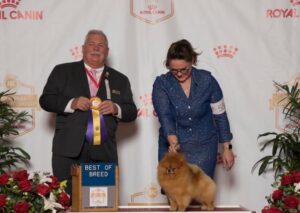
Aly Bell is the breeder behind BallOFur Pomeranians & Infiniti Japanese Chin. Read about the kennel’s beginnings, puppies, photos and more!

Insights from an Owner Handler, Christie Lisenbee. Read about her opinions on various topics about dog handling in the modern show ring.
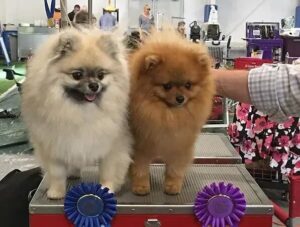
Interview with a Toy Group Breeder Susan & Peter Colcord – We live in New Hampshire. Peter had been involved showing dogs for 25-plus years,

Some Toys Are Not Safe for Toy Dogs – I am writing about a scary experience that we had about a month ago.We had two Pomeranian male puppies
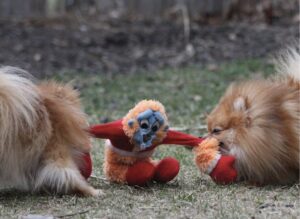
Being and owner and living with any dog comes responsibility. Being an owner and living with a Pomeranian, there are the same responsibilities
The best way to ensure a long and happy relationship with a purebred dog is to purchase one from a responsible breeder. Not sure where to begin?
Contact the National Parent Club’s Breeder Referral Program, which is listed on the AKC Breeder Referral Contacts page.
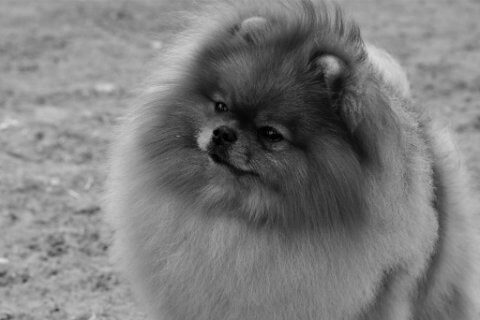

"*" indicates required fields
Showsight Magazine–the world’s most influential purebred dog publication since 1992. Each issue reaches a global audience dedicated to preserving the history and health of purpose bred dogs. Filled with award-winning editorial focused on news and insights from the dog show community, top breeders, handlers, AKC Judges, and more!